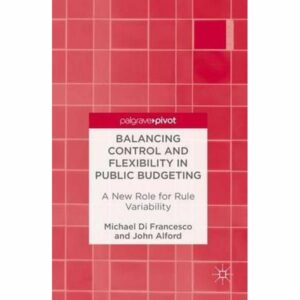The role of central finance agencies as ‘responsive regulator’
5 September 2016
● News and mediaWhen tough times require governments to be flexible in applying public funds, can a central finance agency balance that with the control needed to ensure the integrity of the budget process?
In an important new book, ANZSOG’s Associate Professor Michael Di Francesco and Professor John Alford argue that ‘responsive risk-based regulation’ approaches are a highly effective means of reshaping the role of regulation within government. Their use can help to generate efficiencies and expand the autonomy of agencies in how they use resources and deliver services.
Published by Palgrave Macmillan, Balancing Control and Flexibility in Public Budgeting: A New Role for Rule Variability is the flagship peer reviewed output generated by Michael and John’s ANZSOG-funded project on flexible budgeting practices in government (the others are listed below). Prompted by widespread perceptions – among both practitioners and scholars – that budget practices in the public sector act as ‘hard’ constraints on responsive and collaborative service delivery, the book sets out a two-step approach to balancing control and flexibility.
The first of these is to better understand how and why underlying notions of budget control dominate budget practice in the public sector. The book develops a highly accessible framework for reappraising the role of ‘generic budget rules’ in exercising control, such as those relating to annuality (limiting spending authority to defined reporting periods) and purpose (the way that expenditure is categorised, enumerated and managed). Using the case of the Australian Department of Finance, the book shows how these types of rules interact to generate control capacity and reinforce rigidity, even in the face of reforms designed largely to capture the benefits of devolved budget decision rights.
The second step is the challenging task of scoping how central finance agencies can reconfigure these rules to expand flexibility. Michael and John assess the practical opportunities available to policymakers by articulating the role of ‘rule variability’. They make a novel case for the role of the central finance agency as an internal-to-government ‘responsive regulator’. This means that the finance agency can use information about the compliance of spending agencies to better target interventions, and calibrate those interventions according to the motivation and behaviour of ‘regulatees’. In this context, the book appraises ‘sanctioned rule-breaking’ and ‘earned autonomy’ as two quite radical types of responsive regulation. This design thinking resonates with current developments – earned autonomy, in the form of ‘differential regulation’, is a regulatory option for the resource management framework being implemented as part of the Australian Department of Finance’s Public Management Reform Agenda.
The book has already received high praise: acclaimed US budget expert Professor Paul Posner of George Mason University describes the book as a “path breaking framework to illuminate the tradeoffs and consequences of various forms of budget flexibility for public accountability and efficiency”.
The book is available from Palgrave Macmillan and Springer, where previews are open access.

Related publications from the project are:
Di Francesco, M. (2016) Rules and flexibility in public budgeting: The case of budget modernisation in Australia, Australian Journal of Public Administration, 75(2): 236-248.
Di Francesco, M. and Alford, J. (2016) Budget rules and flexibility in the public sector: Towards a taxonomy, Financial Accountability & Management, 32(2): 232-256.
Di Francesco, M. and Alford, J. (forthcoming) Balancing budget control and flexibility: The central finance agency as ‘responsive regulator’, Public Management Review.
